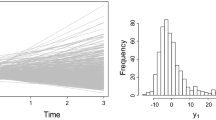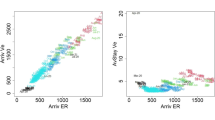The question of whether or not a mixed effects model is required when modelling binary data with inter-subject variability and within subject correlation was reported in this journal by Yano et al. (J. Pharmacokin. Pharmacodyn. 28:389–412 [2001]). That report used simulation experiments to demonstrate that, under certain circumstances, the use of a fixed effects model produced more accurate estimates of the fixed effect parameters than those produced by a mixed effects model. The Laplace approximation to the likelihood was used when fitting the mixed effects model. This paper repeats one of those simulation experiments, with two binary observations recorded for every subject, and uses both the Laplace and the adaptive Gaussian quadrature approximations to the likelihood when fitting the mixed effects model. The results show that the estimates produced using the Laplace approximation include a small number of extreme outliers. This was not the case when using the adaptive Gaussian quadrature approximation. Further examination of these outliers shows that they arise in situations in which the Laplace approximation seriously overestimates the likelihood in an extreme region of the parameter space. It is also demonstrated that when the number of observations per subject is increased from two to three, the estimates based on the Laplace approximation no longer include any extreme outliers. The root mean squared error is a combination of the bias and the variability of the estimates. Increasing the sample size is known to reduce the variability of an estimator with a consequent reduction in its root mean squared error. The estimates based on the fixed effects model are inherently biased and this bias acts as a lower bound for the root mean squared error of these estimates. Consequently, it might be expected that for data sets with a greater number of subjects the estimates based on the mixed effects model would be more accurate than those based on the fixed effects model. This is borne out by the results of a further simulation experiment with an increased number of subjects in each set of data. The difference in the interpretation of the parameters of the fixed and mixed effects models is discussed. It is demonstrated that the mixed effects model and parameter estimates can be used to estimate the parameters of the fixed effects model but not vice versa.
Similar content being viewed by others
References
I. Yano S.L. Beal L.B. Sheiner (2001) ArticleTitleThe need for mixed-effects modeling with population dichotomous data J. Pharmacokin. Pharmacodyn. 28 389–412 Occurrence Handle1:STN:280:DC%2BD3MrntFehsA%3D%3D
SAS Institute. The SAS System for Windows Version 8.02. SAS Institute, Cary, 2001
S. L. Beal and L. B. Sheiner. NONMEM Users Guides (I-VIII). NONMEM Project Group, San Francisco, 1989–1998
E.F. Vonesh (1996) ArticleTitleA note on the use of Laplace’s approximation for nonlinear mixed-effects models Biometrika 83 447–452 Occurrence Handle10.1093/biomet/83.2.447
E. Lesaffre B. Spiessens (2001) ArticleTitleOn the effect of the number of quadrature points in a logistic random-effects model: an example App. Stat. 50 325–335
J.C. Pinheiro D.M. Bates (1995) ArticleTitleApproximations to the log-likelihood function in the non-linear mixed-effects model J. Comput. Graph.l Stat. 4 12–35
P.J. Diggle K.Y. Liang S.L. Zeger (1994) Analysis of Longitudinal Data Clarendon Oxford
Y. Pawitan (2001) In All Likelihood: Statistical Modelling and Inference Using Likelihood Clarendon Oxford
S.L. Zeger K.Y. Liang P.S. Albert (1988) ArticleTitleModels for longitudinal data: a generalised estimating equation approach Biometrics 44 1049–1060 Occurrence Handle3233245 Occurrence Handle1:STN:280:BiaC28nnsV0%3D
Author information
Authors and Affiliations
Corresponding author
Rights and permissions
About this article
Cite this article
Murphy, V., Dunne, A. Mixed Effects versus Fixed Effects Modelling of Binary Data with Inter-subject Variability. J Pharmacokinet Pharmacodyn 32, 245–260 (2005). https://doi.org/10.1007/s10928-005-0045-z
Received:
Accepted:
Published:
Issue Date:
DOI: https://doi.org/10.1007/s10928-005-0045-z




